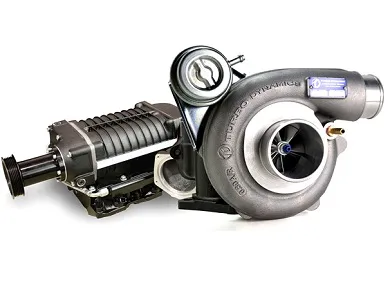Turbochargers and superchargers perform the same function: they compress and push air into the engine. This generates pressure, thus allowing more fuel to be used. This in turn makes the engine produce more power. The whole process is called “forced induction”. However, turbochargers and superchargers perform this process differently. Therefore, it would be wrong to use both words interchangeably to describe either of them.
Here’s the difference between the two systems. The turbocharger uses the pressure from exhaust gases to spin the turbine which is connected to the compressor to compress air. The supercharger uses a belt to the crankshaft of the engine. This is the power source of the compressor as it compresses the air. Now, here are some advantages of using turbochargers and superchargers in vehicles:

Right: Turbocharger
ADVANTAGES OF TURBOCHARGERS
- Turbochargers offer a significant boost to the engine: With these, even small engines can produce enough power for the car, which is why turbo engines can be installed in even the smallest cars.
- It helps in maintaining good fuel economy: Turbocharged small engines use less fuel to idle. This means that the rational and reciprocating mass is reduced, which is great for fuel economy.
- More efficient engines: Turbochargers use energy that is normally lost by being aspirated or supercharged. With this energy, the overall performance of the engine is improved.
DISADVANTAGES OF TURBOCHARGERS
- It takes time to provide enough boost: Due to turbo lag, the car does not immediately speed up. This is a disadvantage to vehicles with big turbochargers.
- Reduced vehicle stability: Reaching the required amount of boost can lead to a power surge. This can cause the tires to lose traction, thus potentially causing an accident.
- Numerous engine oil refills: Owing to the fact that turbochargers get very hot, they tey to get some of the engine’s oil. This means that you have to have a large supply of engine oil at hand at all times. This is quite expensive to maintain.
- Threshold for boost: Turbos are set for a certain range when the exhaust gas required is enough to offer more boost to the engine. However, they do not have a wide range as compared to superchargers.
- Finally, due to the amount of power they produce, turbochargers can easily damage the car engine.
ADVANTAGES OF SUPERCHARGERS
- More horsepower: This is because superchargers are driven by the crankshaft, and thus delivers immediate results.
- Easy to install: There is not much work involved in installing a supercharger. I is also easier to maintain since it does not need intercoolers, unlike in turbochargers.
- It saves engine oil: Since superchargers do not have to heat compressed air, they do not heat up. Hence they do not tap into the engine’s oil supply.
DISADVANTAGES OF SUPERCHARGERS
- Low efficiency: Superchargers are not as efficient as turbochargers, because they are not independent. However, since a supercharger generates as much as 46 percent additional horsepower while consuming 20 percent of the engine’s power output, a lot of people consider it worth the effort.
- They are more expensive to install and maintain: Engines need to be larger and more durable to handle the explosive boosts that superchargers bring. This increases the overall price of the vehicle.
- Don’t miss our mobile phone reviews.
- Follow our news on Google News.
- Join our WhatsApp Group, to be notified of the most important articles and deals,
- Follow us on Instagram, Facebook, Twitter, and YouTube.